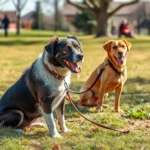
Owning a big dog is a journey filled with unique experiences, both joyous and challenging. Things only big dog owners understand often revolve around the beautiful companionship, the occasional chaos, and the sheer size of our beloved furry friends. Let’s dive into the many aspects of being a big dog owner.
The Joys of Owning a Big Dog
Companionship and Loyalty
Big dogs are known for their immense loyalty and companionship. They often form deep bonds with their owners, providing not just a pet but a true friend. For instance, breeds like the Labrador Retriever or German Shepherd are famous for their loyalty; they’ll stand by your side through thick and thin. You may have experienced a scenario where your big dog senses your mood, offering comfort during tough times. Their affectionate nature and protective instincts make them excellent companions that truly understand their owners.
Physical Presence and Protection
The size of a big dog can be a comforting factor in many situations. When you walk your great Dane or Rottweiler, there’s often a sense of security that comes from their mere presence. Many owners recount stories of their dogs alerting them to potential dangers or acting protectively around children. For example, a big dog may instinctively position itself between the owner and an unfamiliar person, showcasing its protective nature. This physical presence contributes to a sense of safety that smaller breeds simply cannot replicate.
Fun and Playfulness
Despite their size, big dogs have a playful spirit that rivals any smaller breed. Whether it’s a game of fetch with a St. Bernard or a joyful romp through the backyard, their playfulness shines through. They can turn ordinary moments into extraordinary adventures. Their unique ways of engaging in play—like a majestic leap to catch a frisbee or a gentle paw on your lap for attention—remind us that play knows no size limits. The sheer joy they exude while playing is infectious, making even the most mundane days feel special.
The Challenges of Big Dog Ownership
Space Requirements
When it comes to big dogs, space is a vital consideration. They require ample room to move around, stretch, and play. For those living in smaller homes or apartments, it’s essential to find creative ways to make your living space work. Consider investing in vertical space solutions like shelves or dog gates to create a safe environment. Regular outings to dog parks or open fields can also provide the necessary space for your big dog to run freely and enjoy the outdoors.
Exercise Needs
Big dogs have high exercise demands that can be overwhelming for some owners. Regular physical activity is crucial to keep them healthy and happy. Incorporating daily walks, jogs, or play sessions is essential. Engaging in activities like hiking or swimming can also cater to their need for exercise. A well-exercised dog is a happy dog, and finding the right routine that suits both you and your furry friend can make all the difference.
Feeding and Nutritional Needs
Feeding a big dog comes with its own set of challenges. Their dietary requirements differ significantly from smaller breeds, often necessitating a higher quantity of food and specific nutritional considerations. Owners may find themselves spending more on quality dog food to ensure their pet receives the right nutrients. It’s crucial to consult with a veterinarian to determine the ideal diet tailored to your dog’s breed, age, and activity level. Not only does this keep them healthy, but it can also prevent future health issues.
Training Big Dogs
Importance of Early Training
Training a big dog is a fundamental aspect of responsible ownership. Early training is crucial to ensure they grow into well-behaved adults. Large breeds, due to their size and strength, may pose challenges if not adequately trained. Starting with basic commands and gradually introducing more complex commands can help establish good behavior patterns. Many big dog owners find that consistent training from a young age leads to a more manageable and enjoyable pet.
Techniques for Effective Training
Training big dogs requires patience, consistency, and appropriate techniques. Positive reinforcement methods, such as treats and praise, work best with larger breeds. They respond well to clear commands and structured training sessions. Incorporating playtime into training can also help maintain their interest and enthusiasm. Regularly practicing commands in various environments can enhance their adaptability and obedience.
Socialization Challenges
Socializing big dogs is another critical aspect of their training. Introducing them to various environments, people, and other animals can help them develop into well-rounded pets. Puppy classes and playdates with other dogs can be beneficial. If your big dog displays anxiety or aggression towards new situations, gradual exposure and positive experiences can ease this process. Remember, the goal is to ensure they are comfortable and confident in their interactions.
Grooming and Maintenance
Coat Care
Grooming is an essential part of maintaining a big dog’s health and appearance. Different breeds have varying grooming needs; for instance, Golden Retrievers require regular brushing to manage shedding, while Bulldogs may need occasional baths to keep their skin healthy. Keeping their coat clean not only enhances their appearance but also contributes to their overall well-being. Seasonal grooming tips, such as more frequent brushing during shedding periods, can help manage fur around your home.
Health Considerations
Big dogs are prone to certain health issues that owners should be aware of. Conditions like hip dysplasia, obesity, and heart problems are common in larger breeds. Regular vet check-ups and vaccinations are crucial in preventing these issues. Being proactive about their health can lead to a longer, happier life. Additionally, maintaining a healthy weight through proper diet and exercise can significantly reduce the risk of health complications.
Dental and Hygiene Needs
Dental care is often overlooked but is vital for big dogs. Larger breeds are susceptible to dental diseases, which can lead to other health problems. Regular tooth brushing, dental treats, and routine vet check-ups can help maintain their dental hygiene. Beyond dental care, ensuring your big dog’s overall hygiene—such as regular nail trims and ear cleaning—can contribute to their comfort and health.
Lifestyle Adjustments as a Big Dog Owner
Travel Considerations
Traveling with a big dog requires careful planning. Ensuring your furry friend is comfortable during journeys is vital. Consider investing in a spacious, well-ventilated crate for road trips. If you’re flying, check airline regulations regarding pet travel. Researching pet-friendly accommodations can also make your travels smoother. Many hotels now cater to pet owners, ensuring your big dog can enjoy vacations just as much as you do.
Social Life and Public Spaces
Navigating social situations with a big dog can sometimes be tricky. Many public spaces have specific regulations regarding large dogs, and it’s important to be aware of these rules. When visiting parks or outdoor events, always keep your dog on a leash and be courteous to other visitors. Balancing your big dog’s needs while maintaining a social life may require some adjustments, but with proper planning, it can be done.
Family Dynamics
Integrating a big dog into family life can be a rewarding experience. Including children in care routines can foster a sense of responsibility and strengthen bonds. Teaching kids how to interact properly with big dogs is crucial for safety and comfort. Many families find that a big dog enhances their dynamics, providing companionship and joy. However, it’s important to establish boundaries and ensure everyone understands the responsibilities that come with having a larger pet.
The Emotional Connection
Understanding Their Needs
Big dogs have emotional needs that deserve attention. Understanding when they seek affection or when they need space is vital for building a strong bond. Observing their behavior and responding to their cues can enhance your relationship. Regular quality time spent together—whether it’s cuddling on the couch or going for walks—can deepen your emotional connection. The bond formed through understanding can lead to a fulfilling companionship that enriches both your lives.
Coping with Loss and Health Issues
One of the more challenging aspects of being a big dog owner is dealing with health issues and the potential loss of a pet. The emotional toll can be significant, and it’s important to seek support when needed. Recognizing signs of discomfort or illness in your big dog can lead to timely interventions. During difficult times, providing comfort and care can help both you and your dog cope with challenges, fostering a lasting bond even in tough moments.
Conclusion
Owning a big dog is a unique experience filled with both challenges and immense joy. From the loyalty and companionship that these giants provide to the responsibilities of training, grooming, and health care, big dog ownership is a journey that many cherish deeply. Things only big dog owners understand reflect the love, commitment, and fulfillment that come with having a larger-than-life friend by your side. Embrace the journey and enjoy every moment with your big buddy!









